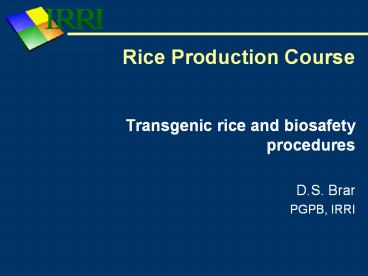Transgenic rice and biosafety procedures - PowerPoint PPT Presentation
Title:
Transgenic rice and biosafety procedures
Description:
Rice Production Course Transgenic rice and biosafety procedures ... selection and evaluation of progenies Wide hybridization (rice x wild species) Tissue culture ... – PowerPoint PPT presentation
Number of Views:171
Avg rating:3.0/5.0
Title: Transgenic rice and biosafety procedures
1
Rice Production Course
- Transgenic rice and biosafety procedures
- D.S. Brar
- PGPB, IRRI
2
Learning objectives
- To describe general methods for rice improvement
- To describe genetic improvement of rice
- To define and describe transgenic rice
- To describe a brief history of transgenics in
rice - To explain production, characterization and
evaluation of transgenic rice
3
Can anyone describe methods for rice improvement?
- Option 1 Management practices
- Agronomic practices (sowing, fertilizer, water,
soil preparation, etc.) - Integrated Pest Management (IPM)
- Integrated nutrient management
- Post harvest losses (drying, storage, etc.)
- Option 2 Genetic improvement
- Option 3 Combination of options 1 and 2
4
What are the methods for genetic improvement of
rice?
- Conventional breeding methods
- Hybridization, backcrossing, selection and
evaluation of progenies - Wide hybridization (rice x wild species)
- Tissue culture (anther culture, somatic cell
culture)
5
- 4. Mutation (create new variation)
- 5. Molecular breeding (use of molecular markers)
- 6. Transformation (genetic engineering)
- Introducing transgene/foreign genes through
recombinant DNA technique but not through sexual
hybridization
6
Can anyone define transgenic rice?
- Broadly speaking refers to any rice plant that
carries foreign gene (s) introduced through
genetic engineering techniques - ?The transgene could be from a micro-organisms
and different plants
7
Transgenic rice
- Gene introduced directly into cultured cells
(callus) and/or organs (immature embryo) using
biolistic or Agrobacterium methods of
transformation - Rice plants are regenerated from transformed
cells and progenies and tested for the desirable
agronomic trait (s) (eg. stem borer resistance)
8
Transgenic rice
- Transgenic rice commonly referred as GM
(genetically modified) rice ?Transgenics are
released into environment after series of
biosafety tests - Biosafety safety of living organisms (human,
microorganisms, plants, animals insects,) - ? IRRI follows biosafety guidelines of NCBP,
Philippines.
9
(No Transcript)
10
(No Transcript)
11
(No Transcript)
12
- A schematic protocol for production of fertile
transgenic plants using - biolistic systems,
- protoplast systems
- Agrobacterium systems
- (Datta,et al.)
13
Brief history of transgenics in rice
- Transgenic rice first produced in 1988
- Two methods commonly used to produce transgenics
- Biolistic
- Agrobacterium mediated
- Both indica and japonica varieties have been
transformed
14
- Transgenic rice have been produced carrying genes
for - herbicide resistance, bacterial blight, virus,
- sheath blight resistance
- stem borer resistance
- high iron, golden rice
- No commercial release of transgenic rice
15
Transgenic rice production, characterization
and evaluation
- Transgene availability local or imported
- Insertion into the elite line
- Growing of transgenics in containment facility
(CL4), low level containment facility (screen
house) - Characterization and evaluation of transgenics
(based on agronomic and molecular chracteristics) - Commercial release of transgenics
16
Transgenic rice with Xa21 gene showing resistance
to bacterial blight
17
Transgenic rice (golden rice) with psy, crtl, lcy
genes possessing B-carotene
18
Transgenic rice with Bt gene showing resistance
to stem borer
19
Some examples of transgenic rice produced at IRRI
Trait Transgene(s) Status
Bacterial blight Xa21 Field tested in India, China and Philippines
Stem borer resistance Bt (cry1A, 1B, 1C, etc) Field tested in China. Bt genes introduced into many cultivars
Sheath blight resistance Chitinase Transgenics show increased tolerance to sheath blight
Abiotic stress tolerance DREB Transgenics produced are under evaluation
Golden rice (ß-carotene) psy, cry1, lcy Many varieties transformed. Backcrossing used to introduce into other varieties by NARES
20
Transgenic rice and biosafety
Biosafety component Activity (ties)
Food and health safety Assessment of GM rice for toxicity, allergenicity and nutritional imbalance
Environmental safety Effect of GM rice on beneficial insects soil micro-organisms non-target species (plants, animals, microbes) Gene flow from transgenic to non-transgenic rice and wild species of Oryza Development of resistance to pests
Capacity building on biosafety of GM rice Training courses/workshop on risk assessment, regulatory processes and public awareness Detection of transgene(s) using PCR kits
21
(No Transcript)
22
(No Transcript)
23
Can anyone briefly summarize the importance of
transgenic rice?
- Questions or comments?































